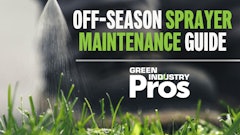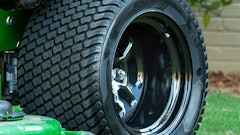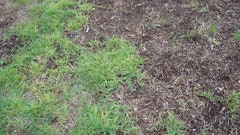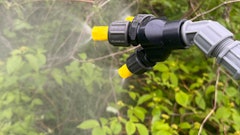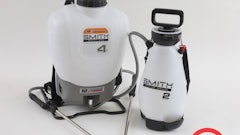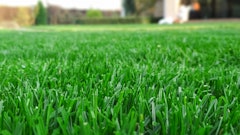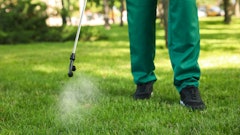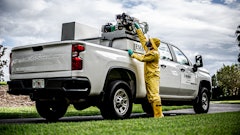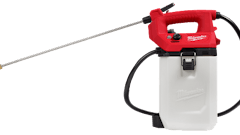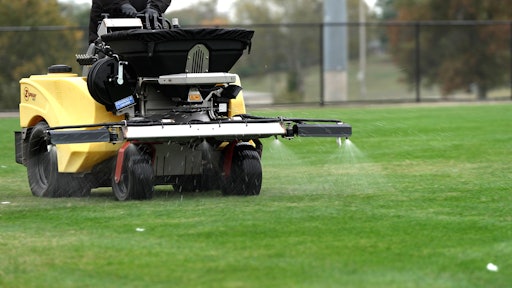
The proliferation of stand-on spreader-sprayers among lawn care professionals is no accident. They’re simply a better tool for the job. However, the machine alone doesn’t make the money; it takes an operator with the skill and background making the right decisions to make any spreader-sprayer perform at its peak.
There’s not one "key" to efficient spreader-sprayer operation. Rather, it’s the result of paying attention to many small details that, when taken as a whole, lead to more consistent, efficient applications. The resulting increased productivity allows you to finish jobs faster, which, in turn, lets you fit more jobs into each day.
Getting started with a new spreader-sprayer
There’s a learning curve involved with any new piece of equipment, and it’s especially so with a stand-on spreader-sprayer. The control placement, weight balance, steering response, maneuverability and speed varies from machine to machine. As such, it’s important to spend enough time learning the controls and handling of any new spreader-sprayer. The goal is to be able to operate all vital controls intuitively, without looking down.
It’s also important to learn the nuances of handling a spreader-sprayer when it’s loaded up with materials. The handling, stability and "feel" of each machine a different, especially when loaded to capacity. As such, it’s important to get a good feel for any new spreader-sprayer before putting it into a production environment.
One trick is to fill the liquid tanks up with water and the spreader up with kitty litter. Then, take the machine to a concrete parking lot and run it to get a feel for the capabilities of the spreader and sprayer. It’s a good test for any new machine and can help you apply materials more consistently when you get it onto client properties.
Calibration matters
Whenever the materials or application rate change, it’s essential to calibrate the machine appropriately. Doing so ensures the spreader-sprayer puts the proper amount of material on the turf. Mixing chemicals should always be done in accordance with manufacturers’ labels, but the calibration process varies from model to model.
For machines that can spread and spray at the same time, we recommend setting the spread pattern for twice the spray width. So, if your spray width is 8 feet, you’d want to set your spreader at 16 feet from the tire tracks. Then, set the application of the spreader to achieve the desired application rate in one complete out and back pass.
Plan for efficiency
Each application job is unique, so it’s important to survey the property to determine the most efficient way to work. It starts with assessing the size and layout of the property, paying particular attention to hills and uneven terrain. Also note any landscaping, yard furniture or other areas that should be avoided and then decide on the most efficient direction and pattern.
Many spreader-sprayers are equipped with spray wands to enable spot treatment of weeds, but some machines work better when spot spraying in reverse than when moving forward. While it doesn’t directly impact the overall application, it’s an important thing to consider when determining the most efficient approach to take on a property.
The other thing aspect to consider is access to the properties, in particular, any gates that may prevent access. In these instances, choosing a more compact steerable spreader-sprayer, as opposed to a larger zero-turn unit, can enable access to the property.
On the turf
Ideally, passes should be as long and straight as possible. That’s not always possible, however, so having a foam marker on the spreader-sprayer is often valuable in helping to maintain application consistency.
Overall, the goal should be to avoid starts and stops that can kill efficiency. Instead, chose a pattern that enables consistent speed both in application and in the turns and transitions. Doing so will make the most of the spreader-sprayer’s capabilities and maximize productivity.
As stated earlier, machines that can spread and spray simultaneously are typically most efficient when the spread width is set to be twice the spray width. Then, adjust the application rate to be applied in an out and back pass.
Must-have accessories
The right mix of accessories can be a game-changer in terms of maximizing the versatility, productivity and ultimately the money-making capability of any spreader-sprayer. While the ultimate mix of accessories can vary, there are a few items that will benefit virtually any lawn care professional.
First, a foam marker is an absolute no-brainer. It’s money very well spent, because it ensures you’re getting the appropriate overlap of materials on the turf. Since overlap is an essential aspect of delivering consistent results for customers, it’s at the top of the list as far as must have accessories.
High-volume spray pumps are becoming more and more popular. Especially as the size and capabilities of the spreader-sprayers continues to grow, high-volume spray pumps enable operators to effectively apply liquids at a wider range of application rates.
The other accessory is an isolated spray tank. This allows different chemicals to be applied without worry of contaminating the primary spray system.
For example, operators can run a nonselective herbicide in the isolated tank without worrying about it going through the plumbing of the primary spray system. It enables more services to be provided simultaneously using the same machine, increasing both efficiency and productivity.
The bottom line
Efficiency in operation is the name of the game with any stand-on spreader-sprayer. A focus on efficient operation enables you to get onto and off of properties faster, fit more jobs into each day and ultimately make more money. Three keys to achieving maximum efficiency are familiarity with the nuances of your spreader-sprayer, using a strategic approach to each property and accessorizing your machine for the unique needs of your business. In doing so, you’ll consistently deliver top notch results for your customers, while maximizing the profitability of your services.




